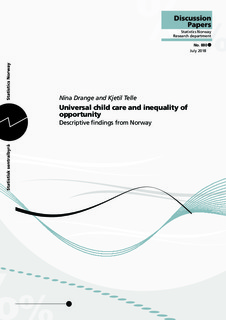| dc.description.abstract | Encouraging effects from random assignments of intensive and high-quality early child care to disadvantaged children have spurred hopes that publicly funded universal child care can improve human development and social mobility.
However, in a universal system advantaged parents can improve the relative performance of their own children if they are better at identifying and occupying the high-quality centers, relegating children from disadvantaged families to low-er quality centers. To avoid such segregation, the universal child care system of Norway is based on strict regulations of structural quality, parental payment and generous public subsidies. Still, using administrative data covering every child in Oslo over the last decade, we document substantial segregation. The segregation results from parents of similar socioeconomic backgrounds applying to the same centers, and partly from private centers cream skimming advan-taged children. Though this can to some extent be explaiend by residential segregation, we show that reallocating chil-dren across centers only 500 meters from their homes would substantially reduce segregation. | nb_NO |
